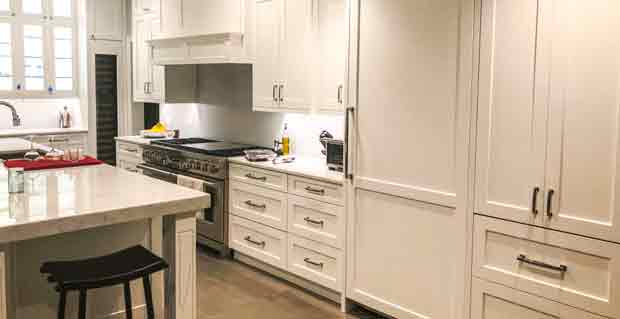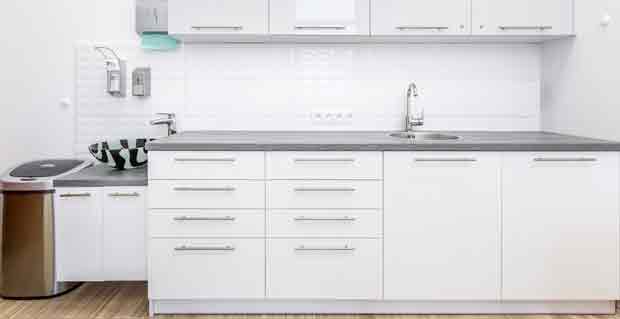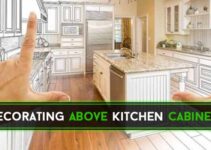Kitchen cabinets are important parts of your home.
They may be designed primarily for the purposes of storing items, but they can be so much more than just that. Well-crafted kitchen cabinets add great value to a home. They can be beautiful additions that immediately make the kitchen setting more inviting.
In this article, you will be able to learn more about the different types of cabinets that you can have installed inside your own kitchen. Some of the kitchen cabinet variants you’ll see are more functional than the standard model, while others introduce a distinct type of styling.
Read on to see which type of kitchen cabinets will fit in best inside your home.
11 Types of Kitchen Cabinets You Can Have Installed in Your Home

1. The Shaker Cabinet
Shaker-style cabinets are ones you will find in many homes.
They are typically made out of wood and they feature a standard interior structure. From a functional standpoint, shaker cabinets are good to have in your home. They can be used to hold a wide number of kitchen tools and any other weighty items you need to keep in storage.
Shaker cabinets won’t wow you with their appearance. They are simply designed and they are crafted with functionality instead of style in mind. That said, something about their minimalist design is still quite appealing.
Kitchens with bolder design schemes could benefit from the addition of the understated shaker cabinets.
2. The Louvered Cabinet
Most would agree, louvered cabinets are definitely more visually striking than the standard shaker cabinets. The wooden slats that serve as the defining characteristics of louvered cabinets look like retro design elements. They also simply look great and would instantly add plenty of value to your kitchen.
It’s worth pointing out that the wooden slats that are found on louvered cabinets have are useful for ventilation as well. That’s why a louvered cabinet can also work well as a smaller pantry if you don’t have the space for one.
3. The Slab or Flat-Panel Cabinet
If you still find the understated design of the shaker cabinet to be too busy for what you’re trying to create inside your kitchen, then maybe the slab-style cabinet will be more your speed.
Also known as flat-panel cabinets, slab cabinets are just, well, they look like slabs. Their distinguishing characteristic is how flat they are. They often come with a small handle so you can actually access their contents.
Aside from brining a minimalist look to your kitchen, slab cabinets can also be used to keep items sealed away pretty well.
4. The Inset Cabinet

You can argue that inset cabinets are the toughest ones to make because so much care and planning has to go into ensuring that they function properly. One miscalculation and the doors set within the cabinet frame may not end up working.
Given all the work that does go in to the construction of an inset cabinet, you should also not be surprised to learn that purchasing or having one built could end up costing you quite a bit of money. That said, if you have the money to spend and would like an exquisite addition to your home, it’s hard to go wrong with inset cabinets.
5. The Distressed Cabinet
Distressed cabinets are known by that name because they are carefully crafted to feature a weathered look. They’re usually made out of wood, and all kinds of techniques can be used to create that distressed appearance.
Obviously, cabinets that feature that weathered look are made to look like antique pieces of furniture. Distressed cabinets bring that distinct antique aesthetic into your kitchen without all the hassle that comes with actually caring for an older fixture.
6. The Beadboard Cabinet
Much like the inset cabinets, the beadboard cabinets are also intricately designed, although the finely crafted elements are less functional this time around. They are usually made out of small wooden planks.
Beadboard cabinets feature indentations known as beads and they serve as borders indicating where one wooden plank ends and where another begins.
The more tactile design of this cabinet type can indeed be appealing, but before you decide to have one installed, you should know that cleaning up those beads is time-consuming.
7. The Thermofoil Cabinet

Not every homeowner has plenty of money to spend just on having intricately-designed cabinets installed. For those looking for a more cost-effective option, the thermofoil cabinet is worth taking a closer look at.
Thermofoil cabinets are not made out of wood. They are fashioned out of medium-density fiberboard. That distinction does matter, but if you’re worried that thermofoil cabinets lack durability, there’s no need to be.
You also don’t need to do a lot to properly care for a thermofoil cabinet. As long as you remember to keep it away from heat sources, a thermofoil cabinet should be able to stay in your kitchen for a long time.
8. The Base Cabinet
Base cabinets don’t feature any kind of distinct visual characteristics. Instead you’ll be able to identify a base cabinet if you see that it was built on top of a floor and has a countertop above it.
If you want to customize the look of the base cabinet in your kitchen, you can do so.
9. The Wall Cabinet
Similar to the base cabinet, the wall cabinet gets its name from where it’s mounted on.
You can find all kinds of wall cabinets. In smaller homes, wall cabinets can be made more compact so that they still fit easily into the kitchen. When there’s more room available in the kitchen, the wall cabinet can be made larger so that it is capable of holding more items.
Wall cabinets can also be designed in a variety of ways, so pick the style that works best for your kitchen.
10. The Pantry or Utility Tall Cabinet
If you are lucky enough to have a spacious kitchen, then you should look into installing a utility tall cabinet, otherwise known as a pantry.
Pantries are massive. They typically extend all the way from the kitchen floor up to the ceiling. They are designed to be wide as well, allowing you to keep all kinds of food and kitchen equipment in them.
11. The Custom-Made Cabinet
The last type of kitchen cabinet you can consider adding to your home does not have a set appearance or form. That’s because you will be the one to determine the appearance and form of your own custom-made cabinet.
The only limitations you can impose on your custom-made cabinets are the dimensions of your kitchen. Be sure to measure your kitchen first before you move ahead with any order.
Once all that is out of the way, you can proceed to enjoying your new set of custom-made cabinets.
One of the easiest mistakes you can make as a homeowner is to overlook the details, and if you don’t take the time to pick out the exact type of cabinet you want in your kitchen, that could lead to you having to spend way too much money just to fix the issue.
With the sheer amount of cabinet options that are currently available, you are guaranteed to find one that will fit seamlessly into the kind of kitchen you want to create.



